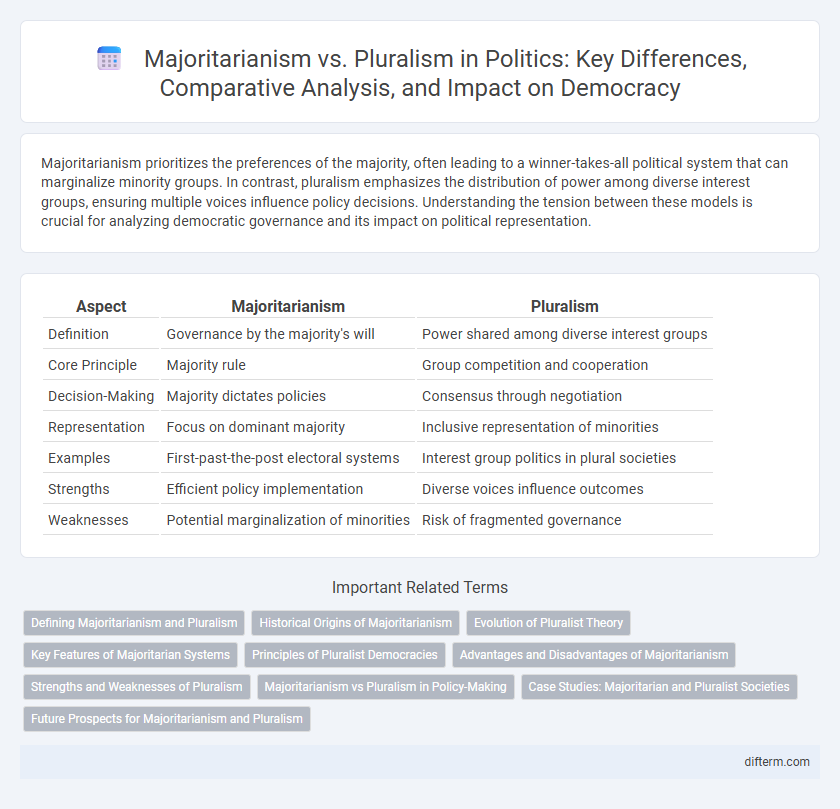Majoritarianism prioritizes the preferences of the majority, often leading to a winner-takes-all political system that can marginalize minority groups. In contrast, pluralism emphasizes the distribution of power among diverse interest groups, ensuring multiple voices influence policy decisions. Understanding the tension between these models is crucial for analyzing democratic governance and its impact on political representation.
Table of Comparison
| Aspect | Majoritarianism | Pluralism |
|---|---|---|
| Definition | Governance by the majority's will | Power shared among diverse interest groups |
| Core Principle | Majority rule | Group competition and cooperation |
| Decision-Making | Majority dictates policies | Consensus through negotiation |
| Representation | Focus on dominant majority | Inclusive representation of minorities |
| Examples | First-past-the-post electoral systems | Interest group politics in plural societies |
| Strengths | Efficient policy implementation | Diverse voices influence outcomes |
| Weaknesses | Potential marginalization of minorities | Risk of fragmented governance |
Defining Majoritarianism and Pluralism
Majoritarianism asserts that the majority's preferences should shape public policies, emphasizing electoral dominance and the direct rule of the majority group. Pluralism, in contrast, promotes the coexistence of diverse interest groups, ensuring that multiple voices influence decision-making processes and prevent the concentration of power. Both frameworks offer distinct pathways for political representation and power distribution in democratic systems.
Historical Origins of Majoritarianism
Majoritarianism traces its historical origins to classical Athenian democracy, where decision-making relied on the majority's will, emphasizing direct participation and collective sovereignty. This system was further solidified during the 18th century Enlightenment period, influencing modern democratic structures by advocating majority rule as a means to prevent tyranny and promote political stability. The evolution of majoritarianism highlights its foundational role in shaping representative governance through prioritizing the majority's preferences in policy decisions.
Evolution of Pluralist Theory
Pluralist theory evolved as a response to majoritarianism by emphasizing the dispersion of power among diverse interest groups, ensuring no single entity dominates decision-making processes. Scholars like Robert Dahl refined pluralism, highlighting how competing groups influence policy outcomes in a democratic system. This evolution underscores the complexity of political power, moving away from simple majority rule toward a more nuanced understanding of societal influence and representation.
Key Features of Majoritarian Systems
Majoritarian systems prioritize the dominance of a single majority group, often leading to the concentration of political power in one party or coalition, which can result in decisive governance but risks marginalizing minority voices. Key features include the use of single-member districts, first-past-the-post voting, and a winner-takes-all approach that enhances government stability but reduces proportional representation. This system typically produces clear electoral outcomes and strong executive leadership, fostering accountability but potentially limiting political diversity and minority representation.
Principles of Pluralist Democracies
Pluralist democracies emphasize the dispersion of power across diverse interest groups, ensuring that no single entity dominates the political landscape. The principles of pluralism promote competition, inclusivity, and compromise, enabling various social, economic, and cultural groups to influence policy-making. This model contrasts with majoritarianism by protecting minority rights and fostering balanced representation in governance.
Advantages and Disadvantages of Majoritarianism
Majoritarianism ensures decisive governance by reflecting the will of the majority, promoting political stability and clear accountability. However, it risks marginalizing minority groups and suppressing diverse viewpoints, leading to potential social fragmentation and unequal representation. The dominance of majoritarianism may undermine inclusivity, limiting democratic pluralism and increasing the likelihood of authoritarian tendencies.
Strengths and Weaknesses of Pluralism
Pluralism fosters diverse interest representation, enhancing democratic inclusivity and preventing monopolization of power by a single group, which strengthens policy responsiveness. However, pluralism can lead to fragmentation and gridlock due to competing interests, potentially slowing decision-making processes. The dispersal of power also risks unequal influence where well-organized groups dominate, undermining true equality in political participation.
Majoritarianism vs Pluralism in Policy-Making
Majoritarianism in policy-making emphasizes decisions made by the majority, often limiting minority influence and streamlining governmental action, while pluralism advocates for diverse group participation to ensure policies reflect a wide range of interests. Majoritarian systems tend to produce clear, decisive policies but risk marginalizing minority viewpoints, whereas pluralist frameworks promote inclusivity and negotiation among interest groups, potentially leading to more balanced yet slower policy outcomes. The tension between majoritarian efficiency and pluralist representation shapes democratic governance, influencing how laws and regulations address varied social and political demands.
Case Studies: Majoritarian and Pluralist Societies
Majoritarian societies like the United Kingdom emphasize governance by the majority, often resulting in decisive policy-making but risking the marginalization of minority groups. Pluralist societies such as the United States showcase multiple organized interest groups competing for influence, fostering a more inclusive but sometimes gridlocked political environment. Case studies reveal that majoritarian systems promote clarity and stability, while pluralist systems encourage diversity and negotiation within democratic frameworks.
Future Prospects for Majoritarianism and Pluralism
Future prospects for majoritarianism hinge on growing demands for simpler, more decisive governance mechanisms as polarized electorates seek clear mandates. Pluralism is likely to advance through expanding digital platforms enabling diverse interest groups to influence policy, promoting more inclusive decision-making processes. The evolving political landscape suggests a potential hybrid model integrating majoritarian decisiveness with pluralistic representation to address complex societal challenges.
majoritarianism vs pluralism Infographic

 difterm.com
difterm.com